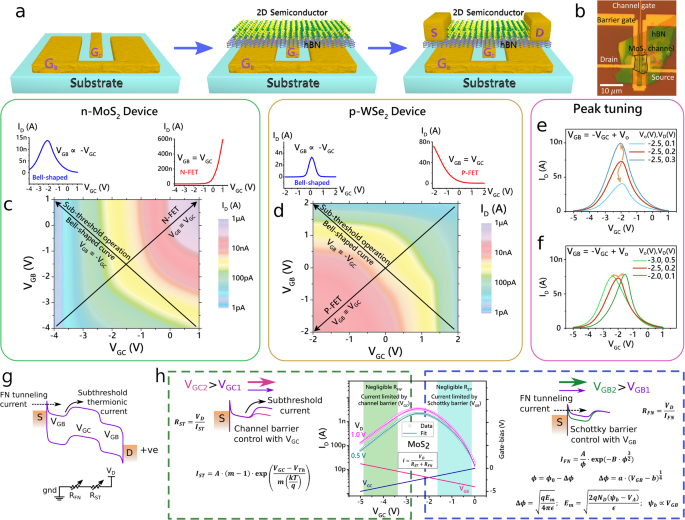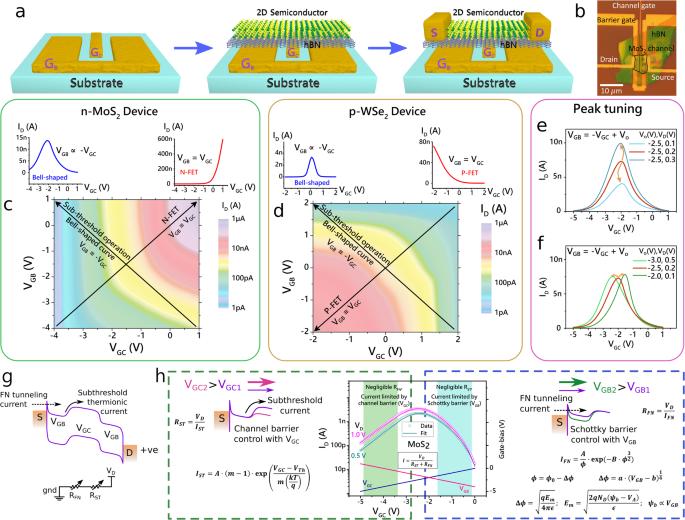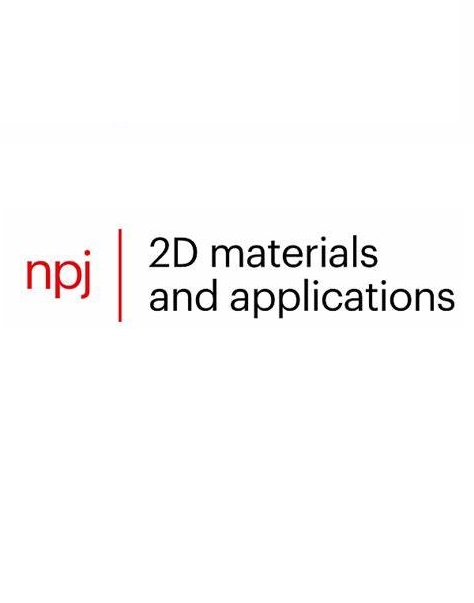使用基于二维材料的亚阈值晶体管实现超低功耗神经形态障碍物检测
IF 8.8
2区 材料科学
Q1 MATERIALS SCIENCE, MULTIDISCIPLINARY
引用次数: 0
摘要
准确、及时和有选择性地检测移动障碍物对于自主机器人可靠地避免碰撞至关重要。基于 CMOS 的尖峰神经元在障碍物检测方面的面积和能效低问题,可以通过基于二维(2D)材料的新兴器件的可重构、可调谐和低功耗运行能力来解决。我们介绍了一种超低功耗尖峰神经元,它采用静电调谐双栅晶体管和超薄通用二维材料沟道。二维阈下晶体管(2D-ST)经过精心设计,可在低电流阈下机制下工作。在广泛的栅极和漏极偏置范围内,通过过势垒热离子和 Fowler-Nordheim 接触势垒隧道电流对载流子传输进行了建模。使用 45 纳米 CMOS 技术元件设计的 2D-ST 神经元电路的仿真结果表明,每个尖峰的能量效率高达 ~3.5 pJ,并能模拟生物 I 级和振荡尖峰。它还展示了复杂的神经元行为,例如对动态视觉系统至关重要的尖峰频率适应和抑制后反弹。小叶巨运动检测器(LGMD)是蝗虫体内一种检测碰撞的生物神经元。我们的神经元电路可以产生类似 LGMD 的尖峰行为,并以 100 pJ 的能量成本检测障碍物。此外,它还可以重新配置,以高选择性区分正在逼近和后退的物体。我们的研究还表明,该尖峰神经元电路能在 2D-ST 电流变化率为 ±40% 以及输入突触电流中的加性白高斯噪声信噪比高达 3 dB 的情况下可靠地工作。本文章由计算机程序翻译,如有差异,请以英文原文为准。


Ultra-low power neuromorphic obstacle detection using a two-dimensional materials-based subthreshold transistor
Accurate, timely and selective detection of moving obstacles is crucial for reliable collision avoidance in autonomous robots. The area- and energy-inefficiency of CMOS-based spiking neurons for obstacle detection can be addressed through the reconfigurable, tunable and low-power operation capabilities of emerging two-dimensional (2D) materials-based devices. We present an ultra-low power spiking neuron built using an electrostatically tuned dual-gate transistor with an ultra-thin and generic 2D material channel. The 2D subthreshold transistor (2D-ST) is carefully designed to operate under low-current subthreshold regime. Carrier transport has been modeled via over-the-barrier thermionic and Fowler–Nordheim contact barrier tunneling currents over a wide range of gate and drain biases. Simulation of a neuron circuit designed using the 2D-ST with 45 nm CMOS technology components shows high energy efficiency of ~3.5 pJ per spike and biomimetic class-I as well as oscillatory spiking. It also demonstrates complex neuronal behaviors such as spike-frequency adaptation and post-inhibitory rebound that are crucial for dynamic visual systems. Lobula giant movement detector (LGMD) is a collision-detecting biological neuron found in locusts. Our neuron circuit can generate LGMD-like spiking behavior and detect obstacles at an energy cost of <100 pJ. Further, it can be reconfigured to distinguish between looming and receding objects with high selectivity. We also show that the spiking neuron circuit can function reliably with ±40% variation in the 2D-ST current as well as up to 3 dB signal-to-noise ratio with additive white Gaussian noise in the input synaptic current.
求助全文
通过发布文献求助,成功后即可免费获取论文全文。
去求助
来源期刊

npj 2D Materials and Applications
Engineering-Mechanics of Materials
CiteScore
14.50
自引率
2.10%
发文量
80
审稿时长
15 weeks
期刊介绍:
npj 2D Materials and Applications publishes papers on the fundamental behavior, synthesis, properties and applications of existing and emerging 2D materials. By selecting papers with the potential for impact, the journal aims to facilitate the transfer of the research of 2D materials into wide-ranging applications.
 求助内容:
求助内容: 应助结果提醒方式:
应助结果提醒方式:


